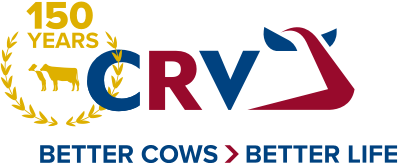“Differences in feed efficiency are very interesting from a financial perspective.”
For Dutch dairy farmer Willem Alders, the feed balance (milk income minus feed costs) is an important economic index. The results of six years of measuring the feed intake of individual cows for CRV opened his eyes to the differences between cows. “The animals with the lowest scores make little or no contribution to the total feed balance, whilst the animals with the best scores produce even more than expected,” he concludes.
Dairy farmer Willem Alders expected that there would be differences in feed efficiency between cows. But the fact the variation within his own herd of 215 cows is so great still surprises the dairy farmer. At Alders family dairy, CRV has been measuring the feed intake of individual cows since 2017. Six years of research has yielded a wealth of data and interesting insights.
“The 25% of cows with the best scores for feed efficiency at our farm produced an average of 39.7 kg (87.5lbs) of fat and protein corrected milk with an intake of 23.1 kg (50.9lbs) of dry matter feed. This means a feed efficiency of 1.72,” says Willem Alders. “For an average production of 32.2 kg (71lbs) of milk, the 25% of cows with the lowest scores required on average 23.9 kg (52.7lbs) of dry matter feed, in other words, a feed efficiency of 1.35.”
Breeding for Feed Efficiency has Potential
According to the dairy farmer, the significant variation in feed efficiency between cows that produce milk on the same ration and under the same conditions can only mean there are significant genetic differences between cows. “There is therefore potential to breed for a higher feed efficiency,” he concludes. “After breeding for production, conformation, and health, breeding for feed efficiency is the next step in cow breeding,” says Alders.
The dairy farmer also emphasizes that feed efficiency cannot be seen in isolation from production, lifespan, health, and fertility. “For example, a heifer with a high feed efficiency that stops producing after one lactation is, of course, never efficient,” he says. In Alders’ opinion, a healthy, high-yielding herd therefore remains the basis of the breeding goal. “However, breeding for feed efficiency is the next step in breeding that can give an extra advantage. That isn’t only interesting from a financial perspective, it also contributes to the sustainability of dairy farming. Because if a cow requires less feed to produce the same amount of milk, there are also lower losses of, for example, nitrogen and methane per kg of milk,” he explains.
Feed Balance an Important Index
The Alders family has an intensive business with milk production of more than 45,000 kg (99,208lbs) of milk per hectare (2.47 acres) and must purchase a large percentage of the feed. “We aim for high milk production of each individual cow as that is the most profitable for us. We have to buy feed and dispose of manure. This means that the feed balance – milk yield minus feed costs – is a very important economic characteristic for us to focus on,” the dairy farmer explains.
The basic ration for the dairy cows contains (based on dry matter) 40 percent feed concentrate products. In addition, the cows are given individual feed concentrate based on production. On this ration, the animals achieve an annual rolling herd average of more than 11,000 kg (24,251lbs) of milk, with 4.30% fat and 3.63% protein.
Efficient with Roughage and Feed Concentrate
The Alders family regularly welcomes groups of livestock farmers to their farm, who wish to learn about the CRV study into feed intake. “A question that is frequently asked is whether breeding for feed efficiency is actually the same as breeding for cows that eat a lot of feed concentrate,” says Alders. He can counter this assumption with figures. “The 25% of cows with the highest feed efficiency ate on average 11.3 kg (24.9lbs) of feed concentrate for a production of 39.7 kg (87.5 lbs) of milk, i.e.: 0.28 kg of feed concentrate per kg of milk (0.28 lbs concentrate per 1 lb milk). The 25% of cows with the lowest feed efficiency require 11.0 kg (24.25 lbs) of feed concentrate for a production of 32.2 kg (71 lbs) of milk, i.e. 0.34 kg of feed concentrate per kg of milk (0.34 lbs concentrate per 1 lb milk). Cows with a high feed efficiency therefore convert both roughage and feed concentrate into milk more efficiently,” he concludes.
Interesting for Every Livestock Farmer
According to the livestock farmer, the differences in feed efficiency are of great significance financially. “A cow with a lactation value of 96 and favorable feed efficiency sometimes proves to be almost as profitable as a comparable stablemate with a lactation value of 106, but an unfavorable feed efficiency,” he cites as a specific example.
“As we purchase a large percentage of the feed, it is immediately visible to us what we earn through improved feed efficiency,” Willem Alders points out. But in his view, extensive farms also benefit from good feed efficiency. “You can sell a surplus of roughage, or you can look for an alternative to add value to the land,” he gives as an example. And he believes feed efficiency is also an interesting trait for livestock farmers to breed for, who do not strive for the very highest milk production. “Livestock farmers who do not use breeding values for feed efficiency miss out on opportunities,” says Willem Alders. “After all, nobody wants to put feed into a cow that doesn’t produce any milk!”
